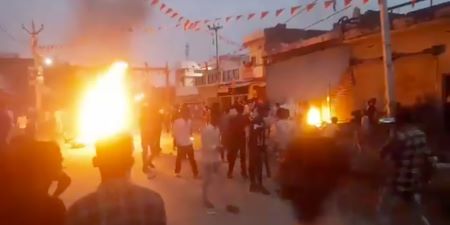In the lead-up to the bye-elections in Uttar Pradesh, communal tensions have flared, fueled by political manipulation aimed at polarizing the electorate.
“Kaheen firqaparasti tanaav hai kya?
Zara maaloom karo, kaheen chunaav hai kya?”
Bye-elections have been announced for nine constituencies in the Uttar Pradesh State Assembly, scheduled for November 13, 2024.
Even before the announcement of the bye-elections, communal tensions in the state had already been ignited, likely by those who stand to benefit from polarizing the electorate.

Violence in Bahraich. Photo: X/@SaralPatel
A clear example of this political manipulation can be seen in the recent violence in Bahraich district, Uttar Pradesh—a pattern we have witnessed time and again, where communal strife is engineered to influence the voting public.
On October 13, a Hindu procession for the immersion of a Durga idol passed through a Muslim-majority neighborhood. Reports suggest that some participants in the procession shouted highly provocative slogans, such as “Jab katwe maare jaayenge, Ram Ram chillaayenge” (When Muslims are killed, they will chant Ram Ram) and “Hindustan mein agar rehna hai, Jai Shri Ram kehna hai” (If you want to live in India, you must say Jai Shri Ram). This inflammatory rhetoric sparked unrest in an already sensitive atmosphere.
The situation escalated when a young man named Ram Gopal Mishra allegedly climbed a building owned by a Muslim family, removed a green flag—often associated with Islam—and replaced it with a saffron flag, symbolizing Hindu nationalism.

A screengrab from a video showing Ram Gopal Mishra replacing an Islamic flag with a saffron flag in Bahraich, a moment that ignited communal tensions.
Mishra was soon killed under unclear circumstances. His death has become a flashpoint, with conflicting narratives about how he died. Regardless of these ambiguities, there is no doubt that his death requires a thorough investigation, and the culprits must be brought to justice.
However, the violence that followed his death was entirely disproportionate, targeting innocent Muslims who had no involvement in the incident. Hundreds of Muslim homes, shops, and even a hospital were attacked, looted, and set on fire.
What is particularly disturbing is the role of law enforcement in this violence. A sting operation conducted by a reporter from Dainik Bhaskar revealed that the police had given Hindu mobs a two-hour window to attack Muslims with impunity. The police stood by or, worse, collaborated with the rioters, mirroring the kind of state-sponsored violence we have seen in darker chapters of history.
Also Read: COURTS & COMMUNAL POLITICS
This is reminiscent of the Nazi era when the police turned a blind eye—or even abetted—the violence carried out by Nazi stormtroopers (S.A.) against Jews, giving them free rein to loot and destroy Jewish properties. Such parallels are chilling but unavoidable when state authorities fail in their duty to protect minorities.

A Muslim resident of Bahraich district in India’s Uttar Pradesh state stands inside her burned house [Arbab Ali/Al Jazeera]
This practice of home demolition as a form of punitive action against a specific community has been criticized as an extra-judicial, discriminatory tactic. Fortunately, the Indian Supreme Court intervened, putting a temporary halt to the demolitions, which could have further inflamed tensions in the area.
As the November bye-elections approach, we can only expect further attempts to divide communities along religious lines.
Also Read: Supreme Court to Rein in “Bulldozer Justice” with New Guidelines
It’s often said that all is fair in love and war, but Indian politics today seems to follow this dictum more closely than ever. Muslims, in particular, have become easy targets in this political “war.” Violence, intimidation, and discrimination are being normalized as tools of electoral strategy.
In this context, it becomes clear that communalism is not just an unfortunate byproduct of political rivalries but a deliberate strategy for electoral gain—one that continues to have devastating consequences for Indian society and democracy. ![]()
Disclaimer : PunjabTodayNews.com and other platforms of the Punjab Today group strive to include views and opinions from across the entire spectrum, but by no means do we agree with everything we publish. Our efforts and editorial choices consistently underscore our authors’ right to the freedom of speech. However, it should be clear to all readers that individual authors are responsible for the information, ideas or opinions in their articles, and very often, these do not reflect the views of PunjabTodayNews.com or other platforms of the group. Punjab Today does not assume any responsibility or liability for the views of authors whose work appears here.
Punjab Today believes in serious, engaging, narrative journalism at a time when mainstream media houses seem to have given up on long-form writing and news television has blurred or altogether erased the lines between news and slapstick entertainment. We at Punjab Today believe that readers such as yourself appreciate cerebral journalism, and would like you to hold us against the best international industry standards. Brickbats are welcome even more than bouquets, though an occasional pat on the back is always encouraging. Good journalism can be a lifeline in these uncertain times worldwide. You can support us in myriad ways. To begin with, by spreading word about us and forwarding this reportage. Stay engaged.
— Team PT

